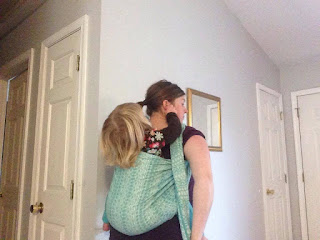This week we bring you Jordan's Back Carry (JBC).
Practice all carries, especially back carries with a spotter, over a bed or couch, or low to the ground until you are completely confident. A BWI meeting is the perfect place to learn new skills with the assistance of a Volunteer Babywearing Educator. In most cases it is best to be comfortable with front carries before attempting back carries. (BWI Babywearing Safety) We recommend waiting until your baby can sit unsupported to begin back carries. You should always try your first back carries with a spotter or over a soft surface such as a bed. However, if you have completely mastered front and hip carries and have successfully back wrapped another baby, it is safe to do back carries in a woven wrap with a baby who isn’t sitting unsupported yet. (BWI Back Wrapping Infants).
Starting with the middle marker on your baby's back, get them onto your back using a method you are comfortable with and make a good seat with fabric flipped up between you going from one knee to the other.
Pin one tail between your legs. Take the other tail and move it under your arm.
Flip this side over your shoulder pulling straight down to keep tension tight.
Spread this pass across your baby's back. Use the bottom rail to reinforce your seat. At the very end tuck the pass under your baby's leg to create a cross pass. Pin this tail between your legs.
Pass the longer tail straight back and spread this across your baby's back.
Once again, using the bottom rail to reinforce your seat.
Bring both tails up to the front and tie a double knot around your waist.
Check back next week for a new Carry of the Week!








































